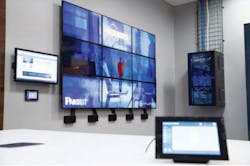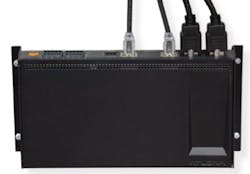By Mike Novak, Panduit
On Thursday, August 15, 2019, I presented a web seminar titled “Cabling for AV Systems,” at cablinginstall.com. The hour-long seminar, which can be viewed at the cablinginstall website until mid-February 2020, concluded with a question-and-answer session. Time prohibited me from answering all the questions from attendees on that day. In this article I provide answers to all questions submitted during that seminar.
Q: What is the minimum category of cable required for HDBaseT?
A: The HDBaseT Alliance recommends using Category 5e cable as a minimum-compliant cable for HDBaseT links. Though a Category 5e is the minimum-compliant cable, Panduit recommends using Category 6A to provide full capabilities of the HDBaseT 5-play, while ensuring best performance for alien crosstalk and Power over Ethernet.
Q: In AV-over-IP designs, where might the encoder/decoder live—at the station side or in an equipment room?
A: Physical locations of equipment depend upon design guidelines and customer needs. The decoder will be placed near end-point devices, displays, and projectors for the purpose of providing the HDMI connection to those devices. Encoders, on the other hand, can be placed in various locations. Depending on the application, these products can live within a telecom closet, in an AV credenza, or simply have a connection to an encoder wallplate. When designing a space, considerations such as security and accessibility should be considered.
Q: Could you have a bandwidth bottleneck of many devices connected to the same edge switch if the network backbone link to the aggregate switch is 1-Gbit or even 10-Gbits?
A: Yes, an improperly sized network could have bottlenecks. A properly designed network should have backbones and aggregation links large enough to account for the sum of all end-device traffic. In a proposed scenario, if 10 Atlona OmniStream encoders are streaming at 900 Mbits/sec each, and there is no other traffic on the link, a 10-Gbit/sec backbone link would perform without issue. But if the scenario increased beyond 11 Atlona OmniStream encoders, the 10-Gbit/sec backbone link would begin to have performance issues as a result of the bandwidth bottleneck.Q: Can you extend the AV using Ethernet extenders?
A: Yes, AV-over-IP works over network bridges, switches, and properly configured routers. An Ethernet extender is a bridge and therefore would work with AV-over-IP.
Q: What is the distance limitation for HDMI over passive HDMI cable for 1080p and for 4K resolutions?
A: Though HDMI doesn’t specify any length limitation on passive cables, a typical signal transmission for 1080p resolution is about 40 feet. Similarly, 4K resolution needs an even greater amount of bandwidth, which will reduce transmission length even further, about 15 feet. Not every HDMI cable is the same, however. Always be sure to see that your cables meet HDMI specifications, and are third-party certified.
Q: If called out to use shielded cable, does it matter if I use shielded jacks or only the shielded cable? What are the pros and cons of this?
A: If the system requires the use of shielded cable, shielded jacks and patch panels designed for shielded jacks must be used. For a shielded system to perform properly, the shield on the cable must be grounded. Shielded jacks provide both the connection to the cable and to the patch panel. Path panels for shielded jacks provide the connection from the jack, and then ground themselves to the rack. If shielded cable is used and not grounded, it will not perform as a shielded cable; the ungrounded shielded cable will be more susceptible to external noise sources.
Q: Would it be easier to scope in Category 6A F/UTP as a standard for both AV and IT?
A: In both AV and IT applications, shielded cables are seldom necessary. Shielded cables are typically used where there are significant sources of EMI, such as a factory floor. Unshielded cables are used almost exclusively in the North America market. They are used because they are less expensive and less complicated to install. For all Category 6A installations, alien crosstalk generated from other neighboring data-transmitting cables is a concern. For best results, use a U/UTP cable that utilizes a segmented barrier tape, such as Panduit’s Vari-MaTriX cable.
Q: Would you recommend that AV infrastructure be separated from the normal business production environment?
A: Yes, but only a separate logical network is recommended. A physically separate network (additional switches) would work but is not necessary. Using logical separation (VLANs) is enough if the backbone links are sized appropriately.
Q: Any performance test results with HDBaseT over 28-AWG Category 6A cable?
A: At this time, we have not tested 28-AWG Category 6A patch cords specifically with HDBaseT. However, we have done extensive TIA channel testing and PoE testing using 28-AWG Category 6A patch cords. These results indicate that 28-AWG Category 6A patch cords are suitable for HDBaseT applications.Q: Are there any special considerations that need to be taken with regard to running power over the same cable that you’re using to run HDBaseT?
A: There are no special considerations required for running PoE over cables transmitting HDBaseT in almost all cases. One exception is in the extreme case of bundling a large quantity of cables running higher levels of PoE. Large bundles of PoE cables can generate enough heat that could lead to errors in data transmission. This can be avoided by choosing the right cable (choose LP-rated cables to be completely worry-free) or breaking the larger bundle into smaller bundles.
Q: Is AV-over-IP or HDBaseT more compatible with HDMI matrix switchers?
A: HDMI matrix switchers come in multiple shapes and sizes. They can differ in quantity of inputs and outputs, type of inputs and outputs, as well as different resolutions. From the perspective of compatibility, both technologies can be compatible with matrix switchers. It all depends on the outputs of the system. If an HDBaseT output is available, then one could connect a category cable and extend HDBaseT to a receiver downstream. If an HDMI output is available, it can be delivered into an AV-over-IP encoder, which will connect to the network. In both cases, the signal will be passed from the switcher to the end point.
Mike Novak is Panduit’s product manager for AV products.


